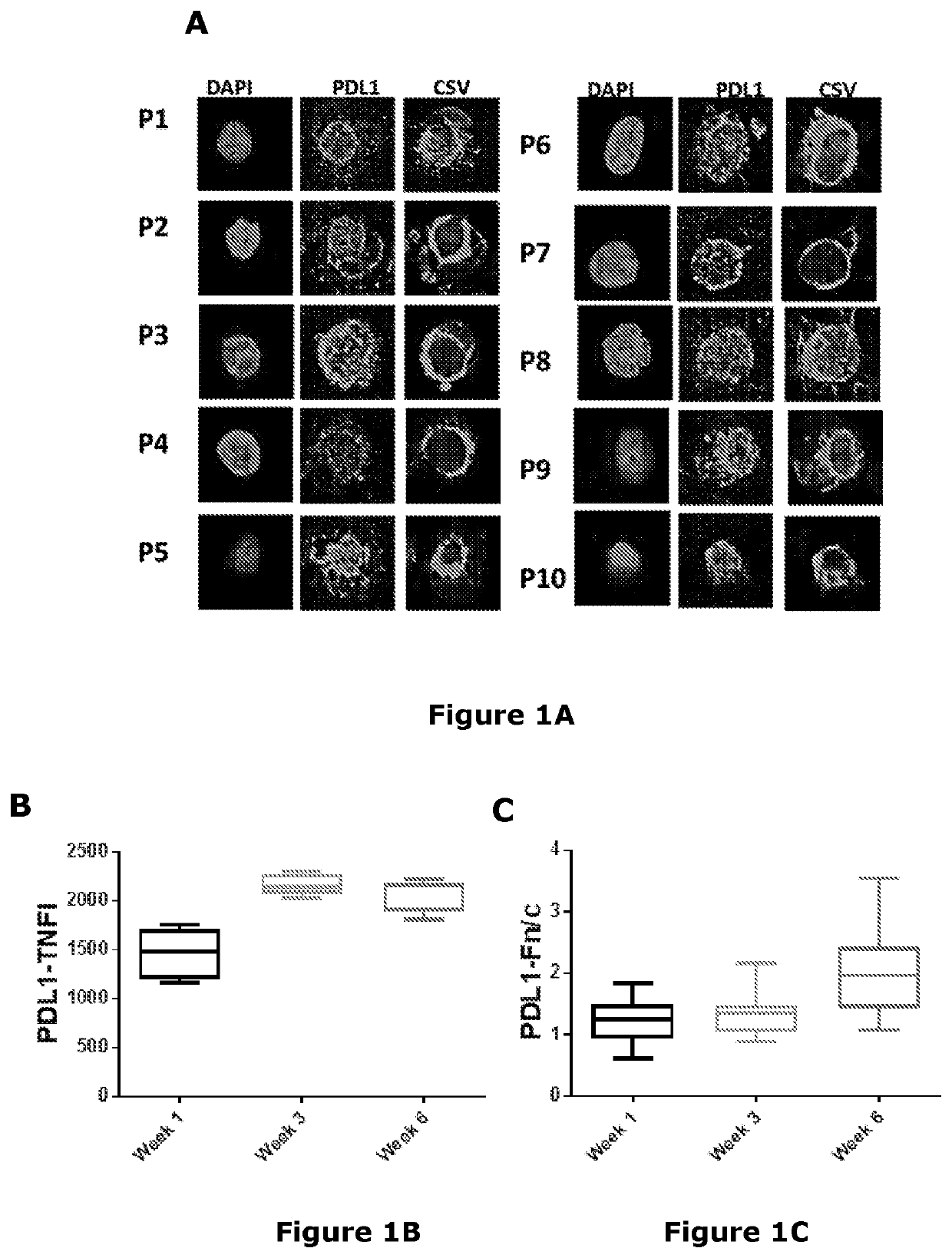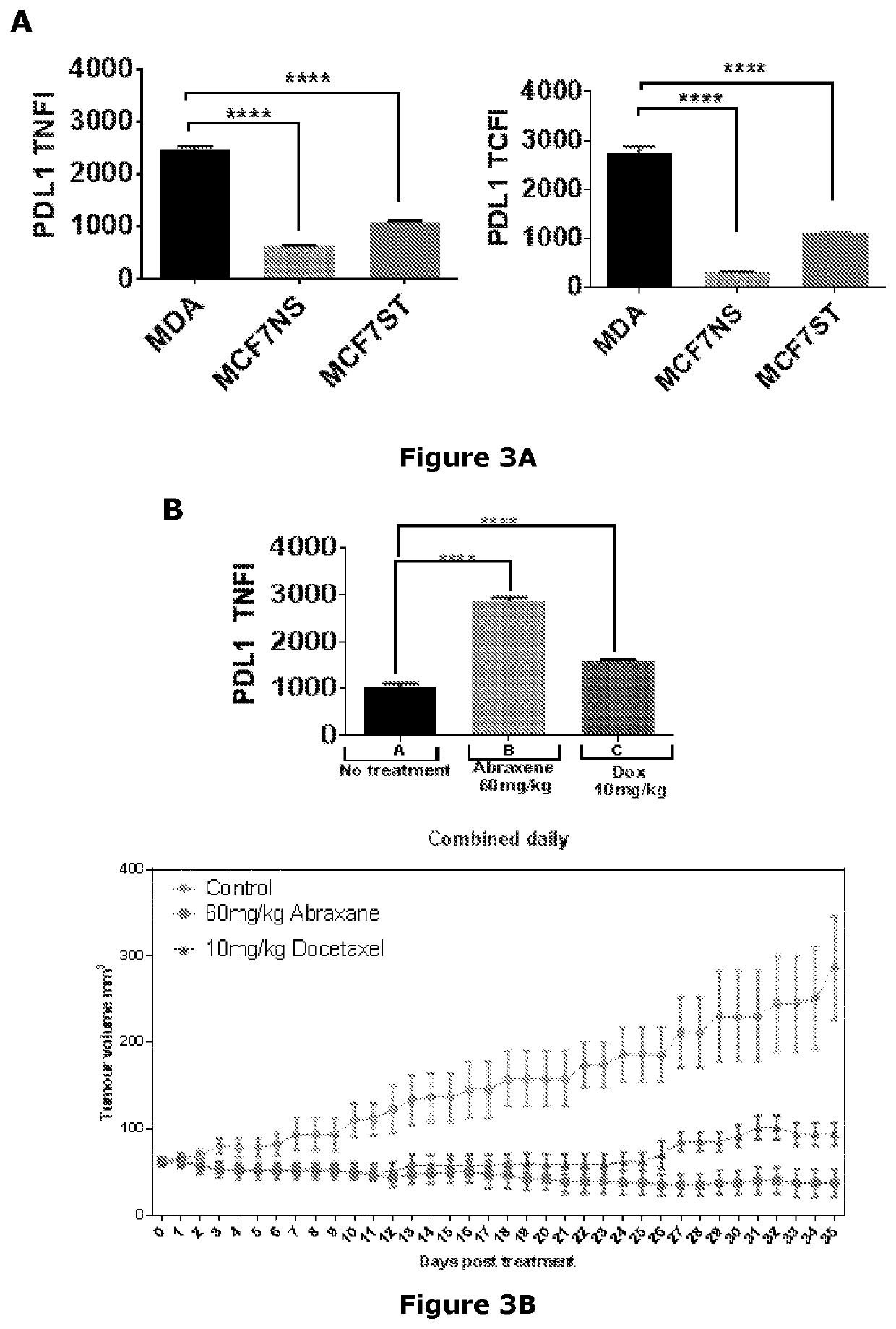Proteinaceous molecules and uses therefor
a technology of proteinaceous molecules and peptides, applied in the field of proteinaceous molecules, can solve the problems of poor outcome and upregulation of pd-l2, and achieve the effect of increasing its nuclear localization
- Summary
- Abstract
- Description
- Claims
- Application Information
AI Technical Summary
Benefits of technology
Problems solved by technology
Method used
Image
Examples
example 1
ion of PD-L1 in Metastasis Initiating Cells (MICs) from Breast Cancer and Melanoma Patients
[0307]Confocal laser scanning microscopy was performed on MICs isolated from liquid biopsies from metastatic breast cancer and melanoma patients. PD-L1 showed significant nuclear localization in both breast cancer (FIGS. 1A to 1D) and melanoma (FIGS. 2A and 2B) cells as indicated by a strong TNFI and a Fn / c score of greater than one.
example 2
ion of PD-L1 in Breast Cancer Cells
[0308]Confocal laser scanning microscopy was performed on MDA-MB-231 (MDA) cells and epithelial (MCF7 NS) or mesenchymal (MCF7 ST) MCF7 cells to examine the localization of PD-L1. PD-L1 was detectable in MDA-MB-231 and epithelial and mesenchymal MCF7 cells, with high nuclear localization in mesenchymal MCF7 cells and MDA-MB-231 cells in particular (FIG. 3A).
[0309]The expression of PD-L1 in mouse MDA-MB-231 xenografts treated for 35 days with abraxane (60 mg / kg) or docetaxel (10 mg / kg) was investigated using confocal laser scanning microscopy. Surviving, resistant MDA-MB-231 xenograft cells treated with abraxane or docetaxel expressed higher levels of PD-L1 in the nucleus compared with untreated cells (FIG. 3B).
[0310]The localization of PD-L1 and the key histone markers, acetylated H3K27 (H3K27ac), trimethylated H3K4 (H3K4me3), and trimethylated H3K9 (H3K9me3), was investigated in MDA-MB-231 cells using confocal laser scanning microscopy. PD-L1 colo...
example 3
K263Q Mutation on Localization of PD-L1 and Expression of Tumor Cell Markers
[0311]Residues 255-271 of PD-L1 were identified as a methylation and acetylation site, with lysine 263 being the methylated / acetylated residue, using high stringency methylation prediction software described in Wen, et al. (2016) Bioinformatics, 32(20): 3107-3115 and acetylation prediction software described in Li, et al. (2014) Sci Rep, 4:5765. To determine the role of acetylation of this site on localization of PD-L1 and expression of tumor cell markers, MCF7 cells were transfected with a plasmid containing the wild-type PD-L1 sequence and a plasmid containing a PD-L1 [K263Q] mutant sequence (Mut1) (FIG. 4). Lysine 263 was replaced with glutamine to prevent acetylation at this position.
[0312]Overexpression of PD-L1 in the cells transfected with the plasmid containing the wild-type PD-L1 sequence resulted in increased expression of cell surface vimentin (CSV) which is a marker for aggressive tumor cells (FI...
PUM
| Property | Measurement | Unit |
|---|---|---|
| Fraction | aaaaa | aaaaa |
| Volume | aaaaa | aaaaa |
| Fraction | aaaaa | aaaaa |
Abstract
Description
Claims
Application Information
 Login to View More
Login to View More - R&D
- Intellectual Property
- Life Sciences
- Materials
- Tech Scout
- Unparalleled Data Quality
- Higher Quality Content
- 60% Fewer Hallucinations
Browse by: Latest US Patents, China's latest patents, Technical Efficacy Thesaurus, Application Domain, Technology Topic, Popular Technical Reports.
© 2025 PatSnap. All rights reserved.Legal|Privacy policy|Modern Slavery Act Transparency Statement|Sitemap|About US| Contact US: help@patsnap.com



